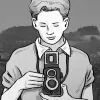Take a look inside 5 images
Svoboda 1945: Liberation
Pros: Powerful story that offers historical context and a lens for today's struggles. Choice-driven and gets students thinking.
Cons: Some of the puzzles ramp up difficulty. The slow pace might not work for some students.
Bottom Line: An excellent game that could complement any curriculum on World War II.
How Can I Teach with This Tool?
Svoboda 1945: Liberation is a mystery and investigation game concerned with a fictional small town on the border of Germany and the Czech Republic. Teachers can use it to give students a window into the impacts and aftershocks of World War II. In the game, the player is an investigator who's working to uncover the history of a schoolhouse in the town. The player must piece together the town's violent and traumatic history during and shortly after WWII. Like the developer's other game, Attentat 1942, Svoboda 1945 does an excellent job of humanizing history. For Svoboda 1945, that means exposing the expulsion of people of German descent from wherever they were living in Europe (similar to the Partition of India or the mass marches of Native Americans).
This game is short enough to include in a classroom setting, perhaps over a week, and would benefit from supplemental activities such as journal writing, class discussion, or post-gameplay research reports. The game is full of artifacts and information, all vetted by historians, that flesh out this time period for students and could spur some of these activities. Additionally, since both Attentat 1942 and Svoboda 1945 feature comic book-style flashbacks, teachers might have students sketch out and draw their own comic books based on the events in the game. Thankfully, the game has an encyclopedia that students can refer to in order to support this work or other learning projects that build on the game's events.













